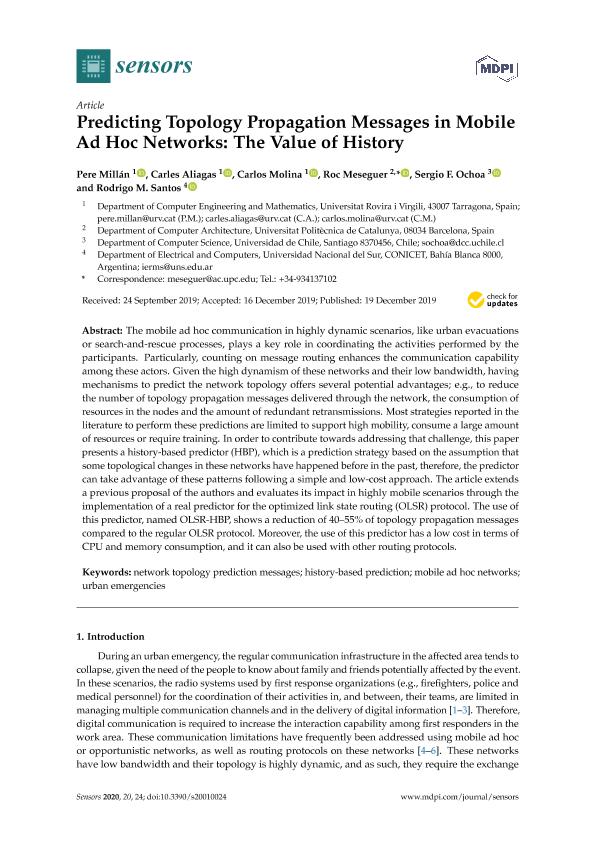Mostrar el registro sencillo del ítem
dc.contributor.author
Millán, Pere
dc.contributor.author
Aliagas, Carles
dc.contributor.author
Molina, Carlos
dc.contributor.author
Meseguer, Roc
dc.contributor.author
Ochoa, Sergio F.

dc.contributor.author
Santos, Rodrigo Martin

dc.date.available
2020-11-12T15:02:15Z
dc.date.issued
2020-01-19
dc.identifier.citation
Millán, Pere; Aliagas, Carles; Molina, Carlos; Meseguer, Roc; Ochoa, Sergio F.; et al.; Predicting topology propagation messages in mobile ad hoc networks: The value of history; Molecular Diversity Preservation International; Sensors; 20; 1; 19-1-2020; 1-24
dc.identifier.issn
1424-8220
dc.identifier.uri
http://hdl.handle.net/11336/118258
dc.description.abstract
The mobile ad hoc communication in highly dynamic scenarios, like urban evacuations or search-and-rescue processes, plays a key role in coordinating the activities performed by the participants. Particularly, counting on message routing enhances the communication capability among these actors. Given the high dynamism of these networks and their low bandwidth, having mechanisms to predict the network topology offers several potential advantages; e.g., to reduce the number of topology propagation messages delivered through the network, the consumption of resources in the nodes and the amount of redundant retransmissions. Most strategies reported in the literature to perform these predictions are limited to support high mobility, consume a large amount of resources or require training. In order to contribute towards addressing that challenge, this paper presents a history-based predictor (HBP), which is a prediction strategy based on the assumption that some topological changes in these networks have happened before in the past, therefore, the predictor can take advantage of these patterns following a simple and low-cost approach. The article extends a previous proposal of the authors and evaluates its impact in highly mobile scenarios through the implementation of a real predictor for the optimized link state routing (OLSR) protocol. The use of this predictor, named OLSR-HBP, shows a reduction of 40–55% of topology propagation messages compared to the regular OLSR protocol. Moreover, the use of this predictor has a low cost in terms of CPU and memory consumption, and it can also be used with other routing protocols.
dc.format
application/pdf
dc.language.iso
eng
dc.publisher
Molecular Diversity Preservation International

dc.rights
info:eu-repo/semantics/openAccess
dc.rights.uri
https://creativecommons.org/licenses/by/2.5/ar/
dc.subject
HISTORY-BASED PREDICTION
dc.subject
MOBILE AD HOC NETWORKS
dc.subject
NETWORK TOPOLOGY PREDICTION MESSAGES
dc.subject
URBAN EMERGENCIES
dc.subject.classification
Otras Ciencias de la Computación e Información

dc.subject.classification
Ciencias de la Computación e Información

dc.subject.classification
CIENCIAS NATURALES Y EXACTAS

dc.title
Predicting topology propagation messages in mobile ad hoc networks: The value of history
dc.type
info:eu-repo/semantics/article
dc.type
info:ar-repo/semantics/artículo
dc.type
info:eu-repo/semantics/publishedVersion
dc.date.updated
2020-09-02T19:06:01Z
dc.journal.volume
20
dc.journal.number
1
dc.journal.pagination
1-24
dc.journal.pais
Suiza

dc.journal.ciudad
Basilea
dc.description.fil
Fil: Millán, Pere. Universitat Rovira I Virgili; España
dc.description.fil
Fil: Aliagas, Carles. Universitat Rovira I Virgili; España
dc.description.fil
Fil: Molina, Carlos. Universitat Rovira I Virgili; España
dc.description.fil
Fil: Meseguer, Roc. Universidad Politécnica de Catalunya; España
dc.description.fil
Fil: Ochoa, Sergio F.. Universidad de Chile; Chile
dc.description.fil
Fil: Santos, Rodrigo Martin. Consejo Nacional de Investigaciones Científicas y Técnicas. Centro Científico Tecnológico Conicet - Bahía Blanca. Instituto de Ciencias e Ingeniería de la Computación. Universidad Nacional del Sur. Departamento de Ciencias e Ingeniería de la Computación. Instituto de Ciencias e Ingeniería de la Computación; Argentina. Universidad Nacional del Sur. Departamento de Ingeniería Eléctrica y de Computadoras; Argentina
dc.journal.title
Sensors

dc.relation.alternativeid
info:eu-repo/semantics/altIdentifier/url/https://www.mdpi.com/1424-8220/20/1/24
dc.relation.alternativeid
info:eu-repo/semantics/altIdentifier/doi/https://doi.org/10.3390/s20010024
Archivos asociados
